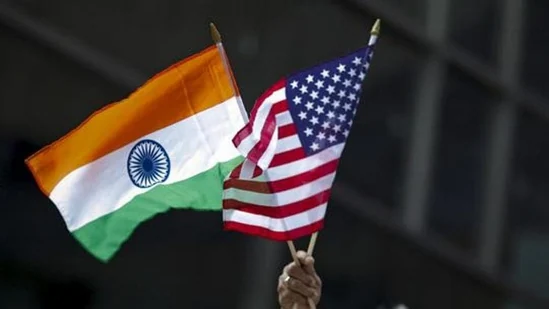While tariffs and trade balances are taking up much news of late, the real story of the US-India partnership is talent. It’s not about who sells what, but about who & how to build and innovate together. As the world’s two largest democracies navigate a volatile economy and a tech-driven future, the movement of skilled people is becoming the most strategic trade route of all.
A man holds the flags of India and the US flag in New York.(REUTERS)
From Silicon Valley boardrooms to hospital research labs, the lasting presence of Indian professionals has for a long time been part of America’s innovation engine. They generate an estimated $85 billion annually for the US economy through STEM, health care, and digital services. Back home, India’s IT-BPM sector, with 5.4 million workers and $253 billion in financial year (FY) 23 revenue, is the backbone of this exchange.
This isn’t a one-way flow. American universities, investors, and R&D institutions bring in funding, training, and frontier technologies that shape India’s next-generation talent. Together, the two nations have built a human-capital corridor that fuels startups, research breakthroughs, and digital ecosystems across continents.
The bottlenecks are now policy, not potential, forcing this powerful relationship to get stuck in slow motion. Visa bottlenecks, unpredictable approval systems, and the lack of clear career pathways are making this essential two-way exchange more difficult at just the time when it’s needed the most. While we speak of a tech revolution, since the pandemic, the rules of labour have been rewritten with the prevailing rise of remote work and, more recently, artificial intelligence.
An updated framework for mobility, on both sides, is needed at this point to avoid the risk of losing momentum —the US could face a shortage of specialised talent, and India could see its skilled workforce underutilised or drifting to other markets. Talent needs to be seen as strategic infrastructure. A mutually agreed-upon roadmap, focusing on mobility, mutual trust, and shared investments, can give the positive traction needed to get this exchange back on track.
For the US–India partnership, mobility must move from being a stopgap visa mechanism to a strategic instrument. The pilot programme offering 5,000 high-skill visas annually is a good start, but it’s just the opening act. A smarter system would tier mobility tracks according to critical sectors—clean energy, semiconductors, biotech, AI—rolling them out in phases, tested, reviewed, and recalibrated as labour market needs shift. The goal is not just quantity, but precision.
Recognition must also evolve. At present, degrees travel slowly; skills should move faster. A mutual framework that acknowledges expertise rather than paperwork—built through joint certification programmes between Indian institutions and US universities—would not only cut bureaucracy but unlock time-sensitive opportunities where talent is needed yesterday, not next quarter.
Physical and intellectual co-creation spaces can anchor this model. Shared talent hubs in Bengaluru and Silicon Valley, seeded with an initial $100 million, could become launchpads for apprenticeships, short-term residencies, and real-time AI skills forecasting. Think of them as living laboratories where policy, capability, and innovation meet.
The professional journey itself needs a digital runway. A secure, interoperable “talent passport” could verify credentials, work histories, and clearances in one place—reducing friction and setting the tone for a globally trusted credentialing system. In a world where time is currency, cutting red tape is a competitive advantage.
Finally, both sides must stop treating skills as a one-way export. Co-investment in training clean-energy engineers, data scientists, and cybersecurity specialists within India is not aid or outreach—it’s smart economics. When both countries help build the workforce of tomorrow, they don’t just share talent; they share the future.
For the US, deeper talent collaboration means resilience. It ensures a steady stream of innovators who strengthen American competitiveness at a time when global tech and research races are tightening. For India, it’s a chance to elevate its role from talent exporter to innovation co-creator. Every skilled professional who moves between the two economies strengthens trust, speeds up technology transfer, and creates new commercial opportunities.
Both countries have the same opportunity before them: to make mobility the backbone of a broader strategic partnership. When talent travels, skill mingles, and ideas cross-pollinate, accelerating innovation. The world’s two largest democracies don’t just have shared values—they have shared talent. Turning that into shared growth is the next great frontier.
This article is authored by Charu Malhotra, co-founder and managing director and Ipsita Gauba, vice president, Primus Partners.
Images are for reference only.Images and contents gathered automatic from google or 3rd party sources.All rights on the images and contents are with their legal original owners.

